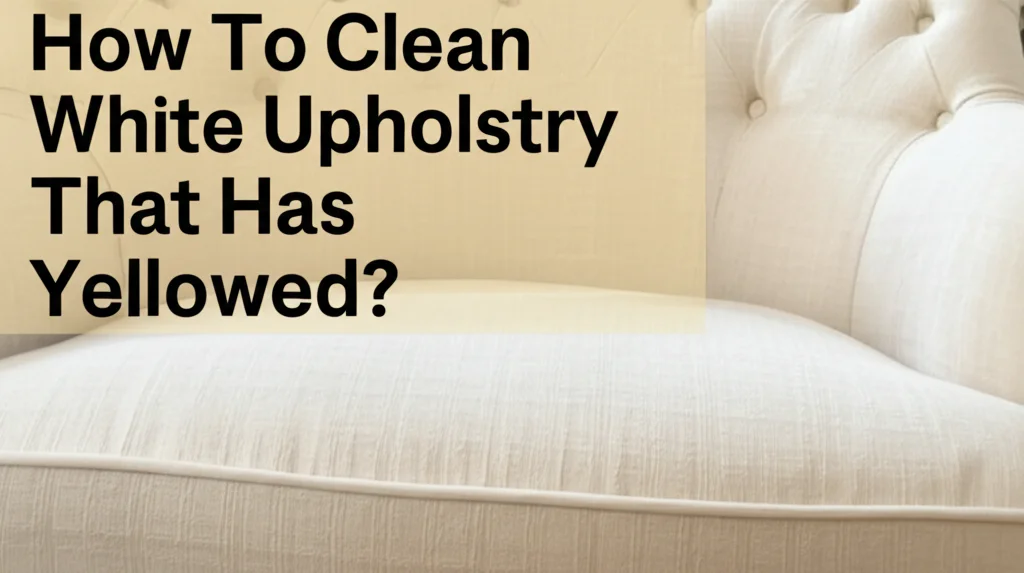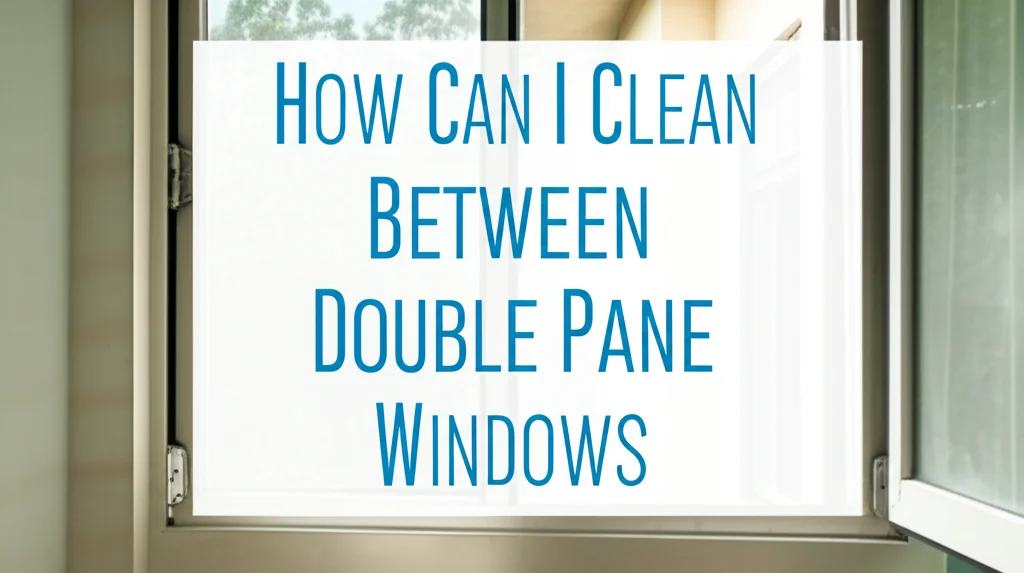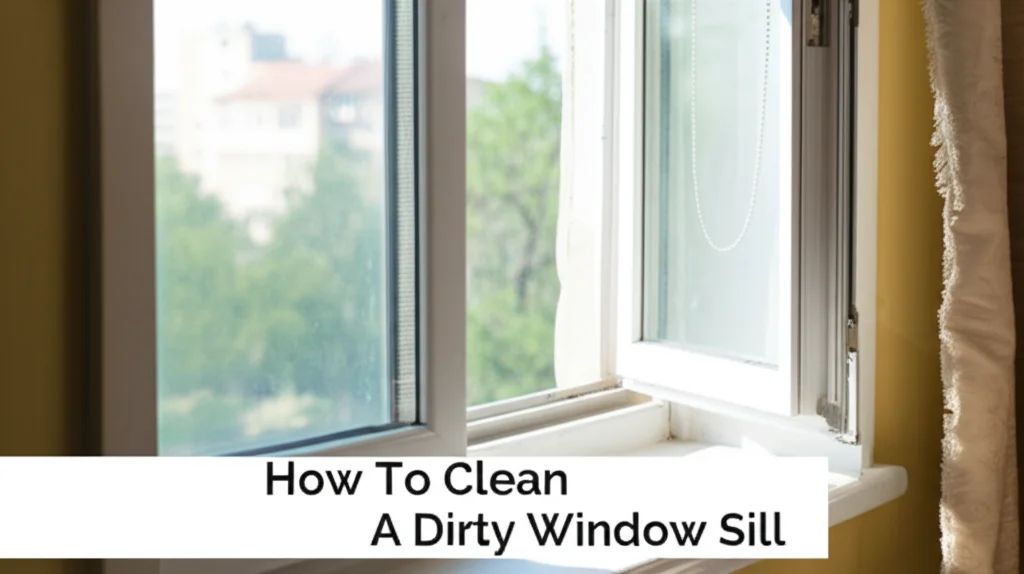· Home Cleaning · 7 min read
How To Clean White Upholstery That Has Yellowed?

Revitalize Your Furniture: How To Clean White Upholstery That Has Yellowed?
Is your once-pristine white upholstery looking a little…yellow? You’re not alone! Over time, white fabrics can develop a yellowish tinge due to dust, dirt, body oils, and even sunlight exposure. It’s a common problem, but thankfully, it’s often fixable. This article will guide you through several methods to clean white upholstery that has yellowed, restoring its brightness and extending its life. We’ll cover everything from simple DIY solutions to when it’s best to call in the professionals. Let’s get started on bringing back that fresh, clean look!
Quick Answer: To clean yellowed white upholstery, start by vacuuming thoroughly. Then, create a cleaning solution of mild dish soap and warm water, gently blotting the fabric. For stubborn yellowing, try a paste of baking soda and water, or a diluted vinegar solution, always testing in an inconspicuous area first.
Key Takeaways:
- Vacuum regularly to prevent dirt buildup.
- Test any cleaning solution in a hidden area first.
- Blot, don’t rub, to avoid damaging the fabric.
- Consider professional cleaning for delicate fabrics or severe yellowing.
Understanding Why White Upholstery Yellows
Before diving into cleaning methods, it’s helpful to understand why white upholstery turns yellow. Knowing the cause can help you prevent it in the future. The primary culprits are environmental factors and everyday use. Dust and dirt, while seemingly harmless, contain oils and pollutants that gradually transfer to the fabric. Body oils, from leaning or sitting on the furniture, also contribute to discoloration.
Furthermore, sunlight exposure can break down the fibers in the fabric, leading to yellowing. Even cleaning products themselves can leave behind residues that contribute to the problem over time. Understanding these factors allows you to take preventative measures, like regular vacuuming and protecting furniture from direct sunlight.
The Power of Regular Vacuuming: Preventing Yellowing
The simplest and most effective way to prevent yellowing is regular vacuuming. Think of it as preventative maintenance for your furniture. Vacuuming removes dust, dirt, and debris before they have a chance to settle into the fibers and cause discoloration. Use the upholstery attachment on your vacuum cleaner to gently remove surface particles.
- Vacuum at least once a week, or more frequently if you have pets or heavy use.
- Pay attention to crevices and seams where dirt tends to accumulate.
- Consider using a brush attachment for delicate fabrics.
- Regular vacuuming extends the life of your upholstery and keeps it looking its best. It’s a small effort with a big reward!
DIY Cleaning Solution: Dish Soap and Water
For mild yellowing, a simple solution of dish soap and water can often do the trick. This is a gentle yet effective method for cleaning many types of upholstery. Mix a few drops of mild dish soap (like Dawn) with warm water in a bowl. Avoid using harsh detergents or bleach, as these can damage the fabric.
Dip a clean, white cloth into the solution and wring it out thoroughly – you want the cloth to be damp, not soaking wet. Gently blot the yellowed areas, working from the outside in to prevent spreading the stain. Avoid rubbing vigorously, as this can damage the fibers. After cleaning, rinse the cloth with clean water and blot the area again to remove any soap residue. Finally, allow the upholstery to air dry completely. If you’re looking for more information on floor cleaning, you might find this article helpful: https://www.beacleaner.com/how-to-clean-luxury-vinyl-plank-flooring/.
Baking Soda Paste: A Natural Brightener
Baking soda is a fantastic natural cleaning agent, and it’s particularly effective for tackling yellowing on upholstery. It’s mildly abrasive, helping to lift stains and brighten the fabric. Create a paste by mixing baking soda with a small amount of water until you achieve a thick consistency.
Apply the paste to the yellowed areas and let it sit for 15-30 minutes. The baking soda will absorb dirt and oils, helping to restore the fabric’s brightness. After the waiting period, vacuum up the baking soda residue thoroughly. For stubborn stains, you can repeat the process. Remember to always test the paste in an inconspicuous area first to ensure it doesn’t damage the fabric. If you’ve ever struggled with residue after cleaning, this article might be useful: https://www.beacleaner.com/how-to-remove-baking-soda-residue-from-carpet/.
Vinegar Solution: A Powerful Stain Remover (Use with Caution!)
Vinegar is a powerful cleaning agent, but it should be used with caution on upholstery. Its acidity can damage certain fabrics, so it’s crucial to test it in a hidden area first. Dilute white vinegar with an equal amount of water in a spray bottle.
Lightly spray the solution onto the yellowed areas, avoiding saturation. Let it sit for a few minutes, then blot with a clean, white cloth. Rinse the cloth with clean water and blot the area again to remove any vinegar residue. Allow the upholstery to air dry completely. The vinegar’s acidity helps to break down stains and brighten the fabric. However, always prioritize testing and use sparingly. If you’re dealing with grout issues, you might find this article helpful: https://www.beacleaner.com/how-to-clean-floor-grout-without-scrubbing/.
Dealing with Stubborn Yellowing: Hydrogen Peroxide (Test First!)
For particularly stubborn yellowing, hydrogen peroxide can be a last resort. However, this should be used with extreme caution, as it can bleach the fabric. Always test in a very inconspicuous area first! Dilute 3% hydrogen peroxide with an equal amount of water.
Apply the solution to the yellowed area with a cotton ball or clean cloth. Let it sit for just a few minutes, then blot with a clean, damp cloth. Rinse the area thoroughly with clean water and allow it to air dry. Monitor the area closely for any signs of discoloration or damage. If you notice any adverse effects, stop immediately. This method is best suited for white, colorfast fabrics.
When to Call a Professional Upholstery Cleaner
Sometimes, DIY methods aren’t enough. If you’ve tried the above techniques and your upholstery is still yellowed, or if you’re dealing with delicate fabrics like silk or velvet, it’s best to call a professional upholstery cleaner. Professionals have the expertise and equipment to safely and effectively clean your furniture without causing damage.
They can assess the fabric type and choose the appropriate cleaning method. They also have access to specialized cleaning solutions and tools that aren’t available to the general public. While it’s an added expense, professional cleaning can save you money in the long run by preventing damage and extending the life of your furniture. If you’re looking for more cleaning advice, you might find this article helpful: https://www.beacleaner.com/2-painless-ways-to-clean-sofa-without-vacuum-cleaner/.
Frequently Asked Questions
Q: Can I use bleach on white upholstery? A: Generally, no. Bleach can damage many upholstery fabrics and cause irreversible discoloration. While it might seem like a quick fix, the risks outweigh the benefits. Always test any cleaning solution in a hidden area first.
Q: How often should I clean my white upholstery? A: It depends on usage, but aim to deep clean at least once a year, and spot clean as needed. Regular vacuuming is crucial for preventing buildup.
Q: What’s the best way to prevent yellowing in the future? A: Regular vacuuming, protecting furniture from direct sunlight, and promptly addressing spills are key preventative measures. Consider using fabric protectors to create a barrier against stains and dirt.
Q: My upholstery has a cleaning code. What does that mean? A: Cleaning codes indicate the recommended cleaning methods. “W” means water-based cleaners are safe, “S” means solvent-based cleaners are required, “WS” means either can be used, and “X” means professional cleaning only.
Bringing Back the Brightness: A Final Word
Cleaning yellowed white upholstery can seem daunting, but with the right techniques and a little patience, you can restore its beauty. Remember to start with the gentlest methods first, always test in an inconspicuous area, and don’t hesitate to call a professional if needed. Regular maintenance and preventative measures will help keep your white upholstery looking fresh and inviting for years to come. By following these tips, you can enjoy your bright, clean furniture without the worry of unsightly yellowing.




